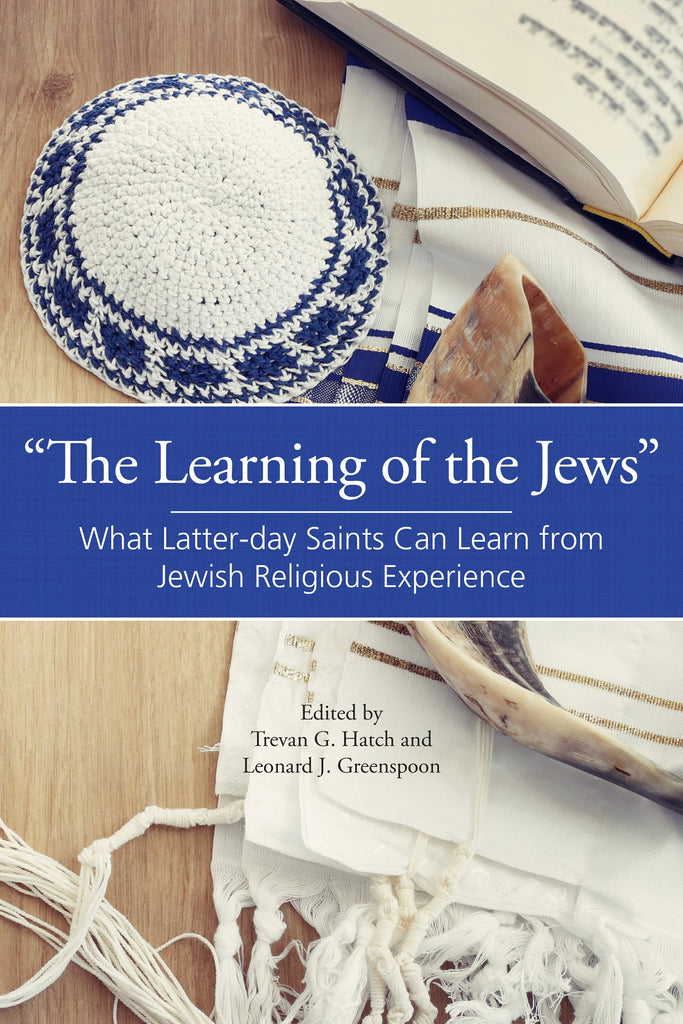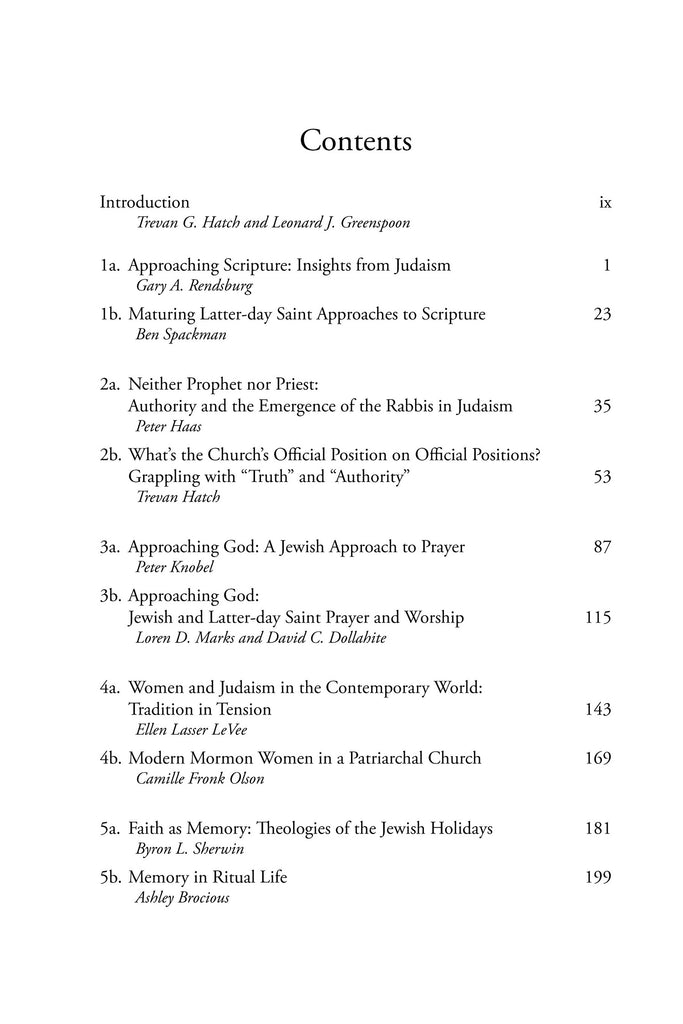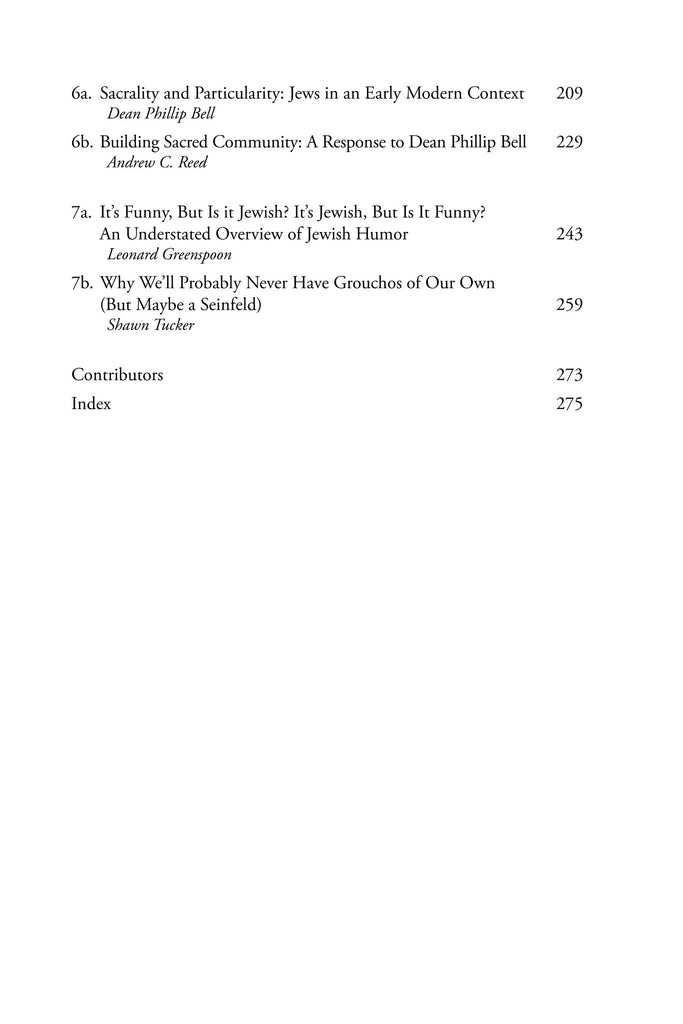“The Learning of the Jews”: What Latter-day Saints Can Learn from Jewish Religious Experience
$25.95
edited by Trevan G. Hatch and Leonard J. Greenspoon
Now available in paperback and ebook.
- “This is a ground-breaking book that provides much needed knowledge on Judaism.” — Yaakov Ariel
- “A landmark in Latter-day Saint embrace of modern Jewish scholarship.” — Jason M. Olson



Available in ebook for Kindle, Apple, Google Play, and Kobo.
Also available through Amazon.
Download a free sample preview.
Book Description:
This volume is about Latter-day Saints learning from Jews and the Jewish experience. This book is unique. It is not a traditional interfaith dialogue where the goal is to learn from each other. Rather, Latter-day Saints seek to give Jews the microphone, so to speak, and let them talk about themselves on their own terms. Only then do Latter-day Saint respond, and not with the goal of establishing areas of agreement or disagreement but as an opportunity to learn from Jews. This book turns to the wisdom of Jews and Judaism to inform, inspire, and enhance the lived religious experience of Latter-day Saints.
The Learning of the Jews brings together fifteen scholars, seven Jewish and eight Latter-day Saint, with a combined academic experience of over four hundred years. The volume is structured around seven major topics, two chapters on each topic. A Jewish scholar first discusses the topic broadly vis-à-vis Judaism, followed by a response from a Latter-day Saint scholar. The seven topics include scripture, authority, prayer, women and modernity, remembrance, particularity, and humor. The intention is that the reader will not only learn a great deal about Judaism and the Jewish experience while reading this volume but also use what they learn to enhance their own cultural and religious experience.
Q&A with the Author:
.
Q: Can you provide a little background about the editors and your decision to do this project together?
A: I participated with Leonard Greenspoon in several Jewish Studies seminars in Chicago from 2012 to 2018. In 2016 I approached him about getting Jewish scholars and LDS scholars together for this writing project. As a prolific scholar in Bible and Jewish Studies for forty years, Leonard has participated in these types of interfaith interactions many times, but never with Latter-day Saints. Leonard and I then contacted several scholars to participate. Many of the Jewish scholars were excited to write essays due to the unique nature of the project.
Q: What makes this book unique among interfaith dialogues?
A: Traditional interfaith dialogues are very common. So why do I call this project “unique”? Customarily, the purpose of interfaith dialogue is for two groups to come together and discuss commonalities. The “Kumbaya” nature of these interfaith dialogues serve to foster understanding and empathy. This project is unique because we did NOT want to follow the typical style of each group learning from each other. In other words, we did not want to tell Jews that Latter-day Saints want to learn from them, but that they must learn from Latter-day Saints as well. Christians have forced Jews for 1,500 years to learn about Christianity (or even convert to Christianity). In this volume, we sought to give Jews “the microphone” so-to-speak and let them talk about their own experience without imposing an agenda on them. Our intent was to discuss and examine Judaism on Jewish terms (as best we can) and subsequently wrestle with how Latter-day Saints might benefit from 3,000 years of the Jewish experience. Our purpose is not to suggest that Latter-day Saints must adopt various Jewish practices and beliefs. Rather, we hoped that the discussions in this volume may assist readers in adopting strategies, mentalities, and approaches to religious and cultural living as exemplified by Jews and Judaism. The chapters are meant to serve as catalysts for further introspection and learning, not as the end-all-be-all for how Latter-day Saints might learn from Jewish religious experience.
Q: How is this book organized?
A: This volume brings together fifteen scholars, seven Jewish and eight Latter-day Saint, with a combined academic experience of over four hundred years. We have structured the volume around seven major topics, two chapters on each topic. A Jewish scholar first discusses the topic broadly vis-à-vis Judaism, followed by a response from a Latter-day Saint scholar. These Latter-day Saint scholars are trained in various fields of study and disciplines including history, sociology, family studies, religious studies, biblical studies, and literature. This wide array of experience and training illustrates the various approaches and perspectives of learning from another group. With the primary purpose of this volume being for Latter-day Saints to learn from Jewish religious perspectives and experiences, the essays are generally different from what you might expect in an interreligious dialogue. For the most part, the Jewish essays were not written with Latter-day Saints in mind but are simply broad overviews that could be helpful for any non-Jewish readership. Likewise, the Latter-day Saint responses are not trying to find commonalities as the primary goal; rather, their purpose is to explore any strategies, mentalities, motives, etc., of Jews that might serve as a catalyst for Latter-day Saints to look introspectively and enhance their own lived religious experience.
Q: Can you highlight some of the main topics discussed in the book?
A: The seven topics include scripture, authority, prayer, women and modernity, remembrance, particularity, and humor. Most of these topics are salient in Jewish discourse today. It so happens that Latter-day Saints focus on several of these topics with a great amount of zeal, especially scripture, authority, prayer, and women & modernity.
Q: What are you hoping that readers will take away from this book?
A: We hope that the reader will not only learn a great deal about Judaism and the Jewish experience while reading this volume, but also use what they learn to enhance their own cultural and religious experience.
Listen to an Authorcast interview with the editors:
Comprehensive Table of Contents:
.
Introduction
- Trevan G. Hatch and Leonard J. Greenspoon
1a. Approaching Scripture: Insights from Judaism
- Gary A. Rendsburg
1b. Maturing Latter-day Saint Approaches to Scripture
- Ben Spackman
2a. Neither Prophet nor Priest: Authority and the Emergence of the Rabbis in Judaism
- Peter Haas
2b. What’s the Church’s Official Position on Official Positions? Grappling with “Truth” and “Authority”
- Trevan Hatch
3a. Approaching God: A Jewish Approach to Prayer
- Peter Knobel
3b. Approaching God: Jewish and Latter-day Saint Prayer and Worship
- Loren D. Marks and David C. Dollahite
4a. Women and Judaism in the Contemporary World: Tradition in Tension
- Ellen Lasser LeVee
4b. Modern Mormon Women in a Patriarchal Church
- Camille Fronk Olson
5a. Faith as Memory: Theologies of the Jewish Holidays
- Byron L. Sherwin
5b. Memory in Ritual Life9
- Ashley Brocious
6a. Sacrality and Particularity: Jews in an Early Modern Context9
- Dean Phillip Bell
6b. Building Sacred Community: A Response to Dean Phillip Bell
- Andrew C. Reed
7a. It’s Funny, But Is it Jewish? It’s Jewish, But Is It Funny? An Understated Overview of Jewish Humor
- Leonard Greenspoon
7b. Why We’ll Probably Never Have Grouchos of Our Own (But Maybe a Seinfeld)
- Shawn Tucker
Praise for "The Learning of the Jews":
“This is a ground-breaking book that provides much needed knowledge on Judaism. Members of The Church of Jesus of Latter-day Saints, as well as Christians of other groups, and Jews as well, will greatly benefit from it. The book also serves as means of intellectual exchange and interaction based on good will between members of the two faiths: Jewish and Mormon. It points to elements that both communities share, and where they differ. The editors gathered a particularly strong group of scholars, and the book chapters offer brilliant and instructive analyses. I highly recommend the book.” — Yaakov Ariel, Professor of Religious Studies, University of North Carolina at Chapel Hill
“The Learning of the Jews is a landmark in Latter-day Saint embrace of modern Jewish scholarship. It represents an understanding that the knowledge and experience of the Jewish people is the key to a more meaningful, relevant future for the Restoration in America and throughout the globe.” — Jason M. Olson, Ph.D., co-author of The Burning Book: A Jewish-Mormon Memoir
“In The Learning of the Jews, we get a series of essays regarding Jewish understanding of scripture and life. . . . Latter-day Saints can then take some of those concepts and enhance their own worship and life experience.” — Joel's Monastery
About the Authors:
 Trevan G. Hatch, PhD, is the Bible, Religious Studies, and Middle East specialist in the Lee Library at Brigham Young University, and is also adjunct professor in the Department of Ancient Scripture. Trevan’s academic training is primarily in Bible and Jewish Studies, and his current research interests are on the Jewish context of the Gospels and Jesus traditions, Messianic expectations of Jews and Christians, and pilgrimage & religious tourism in Israel-Palestine. Trevan is the author of A Stranger in Jerusalem: Seeing Jesus as a Jew (Wipf & Stock Publishers, 2019).
Trevan G. Hatch, PhD, is the Bible, Religious Studies, and Middle East specialist in the Lee Library at Brigham Young University, and is also adjunct professor in the Department of Ancient Scripture. Trevan’s academic training is primarily in Bible and Jewish Studies, and his current research interests are on the Jewish context of the Gospels and Jesus traditions, Messianic expectations of Jews and Christians, and pilgrimage & religious tourism in Israel-Palestine. Trevan is the author of A Stranger in Jerusalem: Seeing Jesus as a Jew (Wipf & Stock Publishers, 2019).
Leonard J. Greenspoon, PhD, holds the Klutznick Chair in Jewish Civilization at Creighton University, where he is also Professor of Theology and of Classical & Near Eastern Studies. Greenspoon is the editor of the 32-volume Studies in Jewish Civilization series. He has also written six other books, including his most recent one on Jewish Bible translations: Jewish Bible Translations: Personalities, Passions, Politics, Progress (JPS & University of Nebraska Press, 2020).
More Information:
298 pages
ISBN: 978-1-58958-499-0 (paperback)
Press Kit







Share this item: